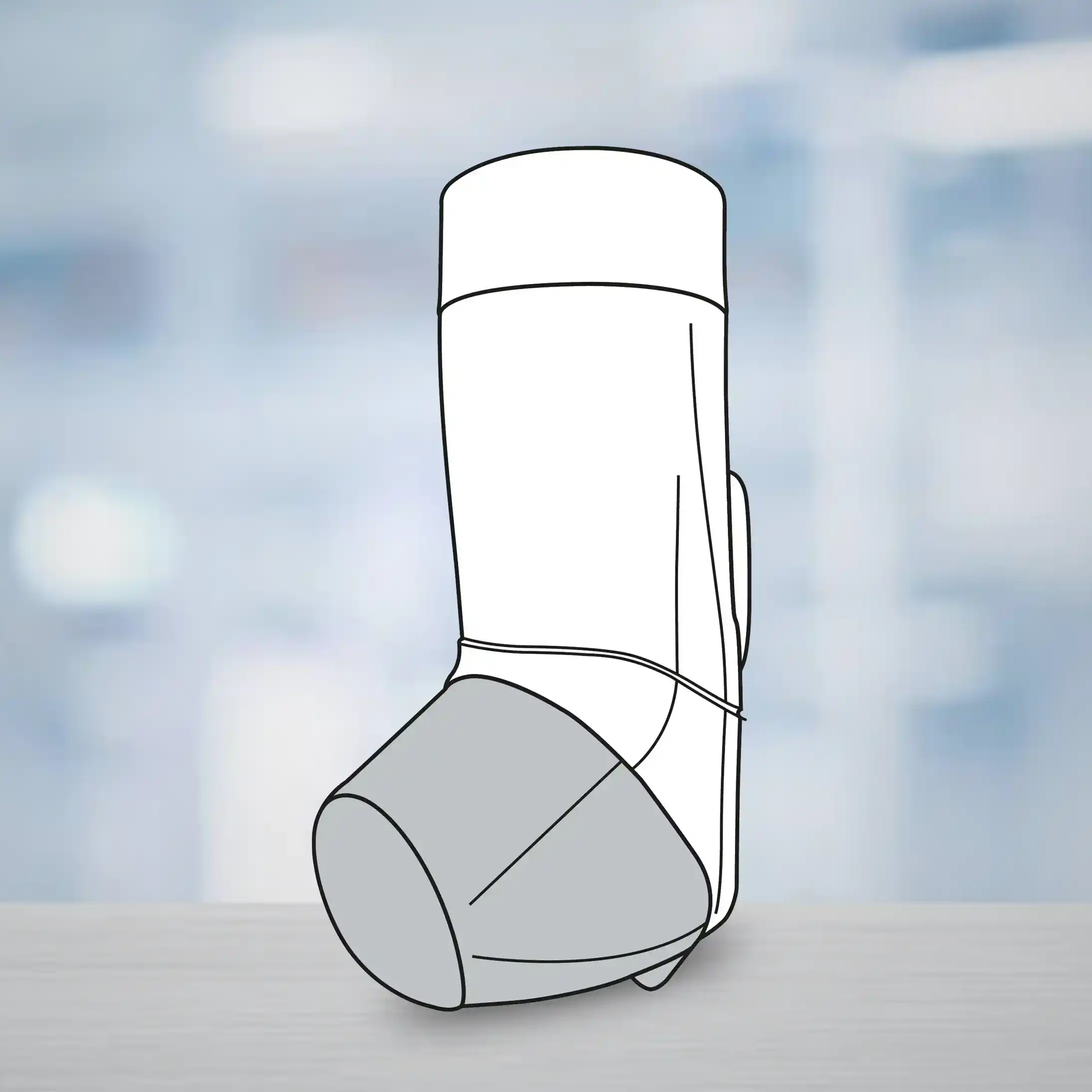Composition
FLOMIST Aqueous Nasal Spray
Each spray delivers:
Fluticasone Propionate BP …...50 mcg
Fluticasone Propionate BP …... 0.05% w/v
Benzalkonium Chloride NF …... 0.01% w/v (as preservative)
Phenyl Ethyl Alcohol USP …..... 0.25% v/v (as preservative)
Dosage Form
Aqueous intranasal spray
Pharmacology
Pharmacodynamics
Fluticasone propionate is a synthetic, trifluorinated corticosteroid with anti-inflammatory activity.
The precise mechanism through which fluticasone propionate affects allergic rhinitis symptoms is not known. Corticosteroids have been shown to have a wide range of effects on multiple cell types (e.g., mast cells, eosinophils, neutrophils, macrophages, and lymphocytes) and mediators (e.g., histamine, eicosanoids, leukotrienes, and cytokines) involved in inflammation.
FLOMIST Aqueous Nasal Spray, like other corticosteroids, is an agent that does not have an immediate effect on allergic symptoms. A decrease in nasal symptoms has been noted in some patients 12 hours after initial treatment with fluticasone propionate aqueous nasal spray. Maximum benefit may not be reached for several days. Similarly, when corticosteroids are discontinued, symptoms may not return for several days.
Pharmacokinetics
Absorption
The activity of FLOMIST Aqueous Nasal Spray is due to the parent drug, fluticasone propionate. Indirect calculations indicate that fluticasone propionate delivered by the intranasal route has an absolute bioavailability averaging less than 2%.
Due to the low bioavailability by the intranasal route, the majority of the pharmacokinetic data was obtained via other routes of administration. Studies using oral dosing of radiolabelled drug have demonstrated that fluticasone propionate is highly extracted from plasma and absorption is low. Oral bioavailability is negligible, and the majority of the circulating radioactivity is due to an inactive metabolite.
Distribution
Following intravenous administration, the initial disposition phase for fluticasone propionate was rapid and consistent with its high lipid solubility and tissue binding. The volume of distribution averaged 4.2 L/kg.
The percentage of fluticasone propionate bound to human plasma proteins averaged 91% with no obvious concentration relationship. Fluticasone propionate is weakly and reversibly bound to erythrocytes and freely equilibrates between erythrocytes and plasma. Fluticasone propionate is not significantly bound to human transcortin.
Metabolism
The total blood clearance of fluticasone propionate is high (average, 1,093 mL/min), with renal clearance accounting for less than 0.02% of the total. The only circulating metabolite detected in humans is the 17beta-carboxylic acid derivative of fluticasone propionate, which is formed through the cytochrome P450 3A4 pathway. This inactive metabolite had less affinity (approximately 1/2,000) than the parent drug for the glucocorticoid receptor of human lung cytosol in vitro and negligible pharmacological activity in animal studies. Other metabolites detected in vitro using cultured human hepatoma cells have not been detected in humans.
Elimination
Following intravenous dosing, fluticasone propionate showed polyexponential kinetics and had a terminal elimination half-life of approximately 7.8 hours. Less than 5% of a radiolabelled oral dose was excreted in the urine as metabolites, with the remainder excreted in the faeces as parent drug and metabolites.
Special Populations
Fluticasone propionate aqueous nasal spray was not studied in any special populations, and no gender-specific pharmacokinetic data have been obtained.
Indications
FLOMIST Aqueous Nasal Spray is indicated for the management of the nasal symptoms of seasonal and perennial allergic and non-allergic rhinitis in adults, adolescents, and paediatric patients, 4 years of age and older.
Safety and effectiveness of fluticasone propionate aqueous nasal spray in children below 4 years of age have not been adequately established.
Dosage and Administration
Adults and Adolescents (12 Years and Above)
Initially, two sprays in each nostril once daily or one spray in each nostril twice daily.
Maintenance: May reduce to one spray in each nostril daily.
Seasonal Allergic Rhinitis: When needed, two sprays in each nostril once daily may suffice.
Children (4-11 Years)
Initially, one spray in each nostril once daily; may increase to two sprays in each nostril once daily.
Maintenance: One spray in each nostril once daily; maximum two sprays in each nostril daily.
Not recommended for use in children below 4 years.
Contraindications
FLOMIST Aqueous Nasal Spray is contraindicated in patients with a hypersensitivity to any of its ingredients.
Warnings and Precautions
In patients who have asthma or other clinical conditions requiring long-term systemic corticosteroid treatment, too rapid a decrease in systemic corticosteroids may cause a severe exacerbation of their symptoms.
Patients who are using drugs that suppress the immune system are more susceptible to infections than healthy individuals. Chickenpox and measles, for example, can take a more serious or even fatal course in susceptible children or adults using corticosteroids. In children or adults who have not had these diseases or been properly immunized, particular care should be taken to avoid exposure.
If exposed to chickenpox, prophylaxis with varicella zoster immune globulin (VZIG) may be indicated. If exposed to measles, prophylaxis with pooled intramuscular immunoglobulin (IG) may be indicated. If chickenpox develops, treatment with antiviral agents may be considered.
Intranasal corticosteroids should be used with caution, if at all, in patients with active or quiescent tuberculosis infections of the respiratory tract, untreated, local or systemic fungal or bacterial infections, systemic viral or parasitic infections, or ocular herpes simplex.
The replacement of a systemic corticosteroid with a topical corticosteroid can be accompanied by signs of adrenal insufficiency and, in addition, some patients may experience symptoms of withdrawal, e.g., joint and/or muscular pain, lassitude, and depression. Patients previously treated for prolonged periods with systemic corticosteroids and transferred to topical corticosteroids should be carefully monitored for acute adrenal insufficiency in response to stress.
A drug interaction study in healthy subjects had shown that ritonavir (a highly potent cytochrome P450 3A4 inhibitor) can significantly increase plasma fluticasone propionate exposure resulting in significantly reduced serum cortisol levels. During post marketing use, there have been reports of clinically significant drug interactions in patients receiving fluticasone propionate and ritonavir, resulting in adrenal suppression and Cushing's Syndrome.
Therefore, co-administration of fluticasone propionate with ritonavir is not recommended unless the potential benefit to the patient outweighs the risk of systemic corticosteroid side-effects.
Avoid spraying into the eyes.
Drug Interactions
Fluticasone propionate is a substrate of cytochrome P450 3A4. Co-administration of fluticasone propionate and the highly potent cytochrome P450 3A4 inhibitor, ritonavir, is not recommended.
Caution should be exercised when fluticasone propionate nasal spray is coadministered with ketoconazole and other lnown potent cytochrome P450 3A4 inhibitors.
The concomitant use of intranasal corticosteroids with other inhaled corticosteroids could increase the risk of signs or symptoms of hypercorticism and/or suppression of the HPA axis.
Pregnancy
Pregnancy Category C
There are no adequate and well-controlled studies in pregnant women. Fluticasone propionate should be used during pregnancy only if the potential benefit justifies the potential risk to the foetus.
Lactation
It is not known whether fluticasone propionate is excreted in human breast milk. However, other corticosteroids have been detected in human milk. Since there are no data from controlled trials on the use of intranasal fluticasone propionate by nursing mothers, caution should be exercised when fluticasone aqueous nasal spray is administered to a nursing mother.
Paediatric Use
Controlled clinical trials have reported that intranasal corticosteroid may cause reduction in growth velocity in pediatric patients. The growth of pediatric patients receiving FLOMIST Aqueous Nasal Spray should be monitored routinely (eg. via stadiometry). Safety and effectiveness of fluticasone nasal spray in children below 4 years of age have not been established.
Undesirable Effects
Rarely, immediate hypersensitivity reactions or contact dermatitis may occur after the administration of FLOMIST Aqueous Nasal Spray. Rare instances of wheezing, nasal septum perforation, cataracts, glaucoma, and increased intraocular pressure have been reported following the intranasal application of corticosteroids, including fluticasone propionate.
Hypersensitivity reactions can also occur, including angio-oedema, skin rash, oedema of the face and tongue, pruritus, urticaria, bronchospasm, wheezing, dyspnoea, and anaphylaxis/anaphylactoid reactions, which in rare instances, were severe.
A common effect observed with use of fluticasone propionate nasal spray is epistaxis and irritation of nasal mucous membrane.
Other adverse events include alteration or loss of sense of taste and/or smell and, rarely, nasal septal perforation, nasal ulcer, sore throat, throat irritation and dryness, cough, hoarseness, voice changes, headache, pharyngitis, epistaxis, nasal burning/ nasal irritation, nausea/ vomiting, asthma symptoms, cough, abdominal pain, diarrhea, fever, flu like symptoms, aches and pains, dizziness and bronchitis.
Other adverse events that occurred in less than 3% but more than 1% patients and that were more common with fluticasone propionate included: blood in nasal mucous, runny nose, abdominal pain, diarrhoea, fever, flu-like symptoms, aches and pains, dizziness and bronchitis.
Dryness of eyes, irritation, conjunctivitis, blurred vision, glaucoma, increased intraocular pressure, and cataracts have been reported.
Cases of growth suppression have also been reported for intranasal corticosteroids.
Overdosage
Use of excessive doses of corticosteroids and/or chronic overdosage may lead to signs or symptoms of hypercorticism and/or suppression of the HPA axis.
Administration of doses higher than those recommended over a long period of time may lead to temporary suppression of adrenal function. In these patients, fluticasone propionate treatment should be continued at a dose sufficient to control.
Intranasal administration of 2 mg (10 times the recommended dose) of fluticasone propionate, twice daily for 7 days, to healthy human volunteers was well tolerated. Single oral doses up to 16 mg have been studied in human volunteers with no acute toxic effects reported. Repeat oral doses up to 80 mg daily for 10 days in volunteers and repeat oral doses up to 10 mg daily for 14 days in patients were well tolerated.
Packaging Information
FLOMIST Aqueous Nasal Spray: Each canister contains 100 metered doses

.svg?iar=0&updated=20230109065058&hash=B8F025B8AA9A24E727DBB30EAED272C8)


